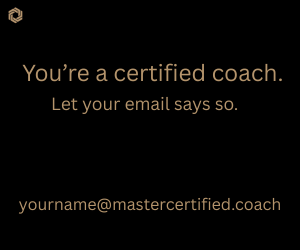“I don’t really know you, so I’m not sure you intend this interpretation, but why do you say ‘mmmm’ when your client answers a question? You sound very negative,” offered a peer who was listening to a session. I sat on the other end of the call stunned, my jaw suddenly gaping wide open. Negative? I knew I was enthusiastically positive the entire session. What in the world was my colleague picking up on? In frustrated desperation, I turned to my coach mentor for help.
“You make a lot of nonverbal noises. Each emphatic ‘mmmm’ or contemplative ‘hmmm’ assigns value to what your client just said,” my mentor commented. I slapped my forehead as it finally clicked. I thought I was communicating, “I hear you, I’m here, keep going,” without interrupting my client. I thought I was neutral. Without realizing it, my automatic inflections interjected my views onto their answers. My words worked with me, but my subtle response noises betrayed me. With so much focus on the words themselves, I wasn’t in tune with my nonverbal responses during, and following, a client answer. Worse still, what I meant to convey was not always received how I intended.
Everything We Do Communicates
As coaches, everything we communicate assigns value or judgment to what our client just said. The position of influence we hold as a professional coach also means our clients may be listening for value or judgment we don’t intend. Their stress, fears or anxiety over the topic of discussion could easily lead them to conclude we meant something we didn’t with that long, drawn out hmmm. I may have genuinely meant nothing more than, “I hear you. Keep going,” but they may have heard, “That was a stupid thought. Try again.”
Be Intentional. Communicate on Purpose
It’s a bit ironic actually. I see it instantly in my clients, but I’ve missed turning the mirror back to myself. I’ve spent years focused on hearing what the client is really saying (and not saying). I’m in tune with the change in their tone, their subtle responses through noises, or shifts in posture, but am I as aware of my own? I’m highly aware of each word I form, but I’ve noticed it is much harder to harness my nonverbal noises. At least, that’s been the case for me until recently.
A winning moment for a coach is the silence of contemplation that follows a powerful question. But what do we do in the space following their powerful answer? In non-coaching conversations, an enthusiastic nod or an energy-filled mmmm may go unnoticed, but as a coach, everything we say or mumble impacts the coaching. So when choosing to communicate through mmmm, do it on purpose.
But How? Limit Your Non-input Input
Increase your awareness of your own nonverbals with these three simple steps.
1) See Yourself
Watch what you do while coaching. If coaching on the phone, set a mirror in front of you. On video chat? Focus on your own video feed and not just the client’s. In person? Either watch your reflection on your notes page or glance down and look at your posture every few minutes.
Trick to try: Nod in your mind, not with your head. Use visualization techniques to respond in a way that only impacts you.
2) Hear Yourself
Listen and pay attention when you react audibly. Increase your awareness and catch yourself in real time by making a tally mark on your notes each time you make a reaction noise (hmmm, mmmm, ohhh, huuuhhh).
Trick to try: Listen back to a session and tally how many times you inserted an audible reaction. Compare your two tallies. How aware were you in real time?
3) Hold On To Yourself
Literally. Find a tactile habit to keep your unintentional mmmm and hmmm inside. Figure out your response triggers (what did the client just say or do that made you respond nonverbally?) and develop a habit to stop your unintentional input.
Trick to try: Press a finger or a fist over your mouth while listening, or rest your mouth and chin on the palm of your hand to remind yourself that anything coming out of you will assign value.
Use an Mmmm to Make a Difference
A well-placed and purposeful mmmm can be a powerful tool we use in coaching. In a constantly changing and digital world where we communicate so much through written forms of communication (emails, texts, chats, images, tweets, etc.), I wonder how much more our clients read into an audible response or a posture change we make? What kind of an impact does my reaction noise have now (versus ten years ago, for example) when so few of our current interactions are absorbed audibly and truly in real time? Making an mmmm on purpose may be the coaching equivalent of using a photo instead of saying a thousand words.
Disclaimer
The views and opinions expressed in guest posts featured on this blog are those of the author and do not necessarily reflect the opinions and views of the International Coach Federation (ICF). The publication of a guest post on the ICF Blog does not equate to an ICF endorsement or guarantee of the products or services provided by the author.
Additionally, for the purpose of full disclosure and as a disclaimer of liability, this content was possibly generated using the assistance of an AI program. Its contents, either in whole or in part, have been reviewed and revised by a human. Nevertheless, the reader/user is responsible for verifying the information presented and should not rely upon this article or post as providing any specific professional advice or counsel. Its contents are provided “as is,” and ICF makes no representations or warranties as to its accuracy or completeness and to the fullest extent permitted by applicable law specifically disclaims any and all liability for any damages or injuries resulting from use of or reliance thereupon.
Post Type
Blog
Audience Type
Coach Educators, Experienced Coaches, External Coaches, ICF Chapter Leaders, Internal Coaches, New Coaches, Professional Coaches, Team and Group Coaches
Topic
Coaching Toolbox, Discover - Your Coaching Career
Related Posts
The Coaching Trap: When Empathy Becomes Exhaustion
Prepare yourself for the fact that this will not be about you…
Your Guide to Preparing for the ACC Exam
Much like a smartphone upgrade that introduces improvements for a smoother user…
How Coaching Is Driving Inclusion Around the Globe: Lessons from Local ICF Chapters
When a group of mothers in Kazakhstan, many of whom had never…








